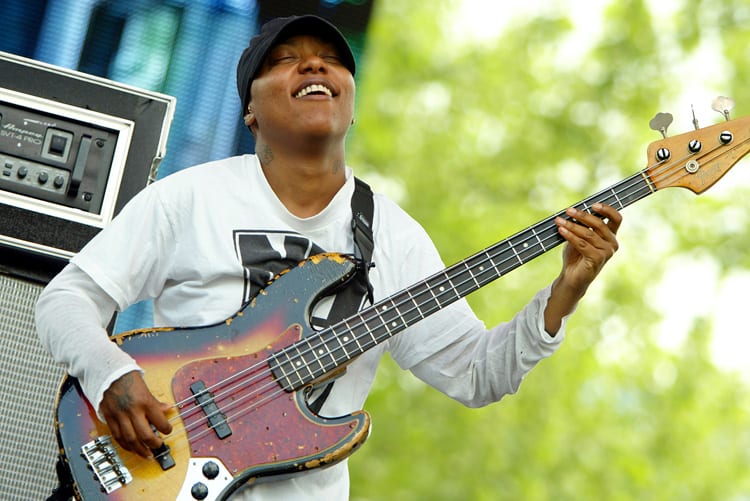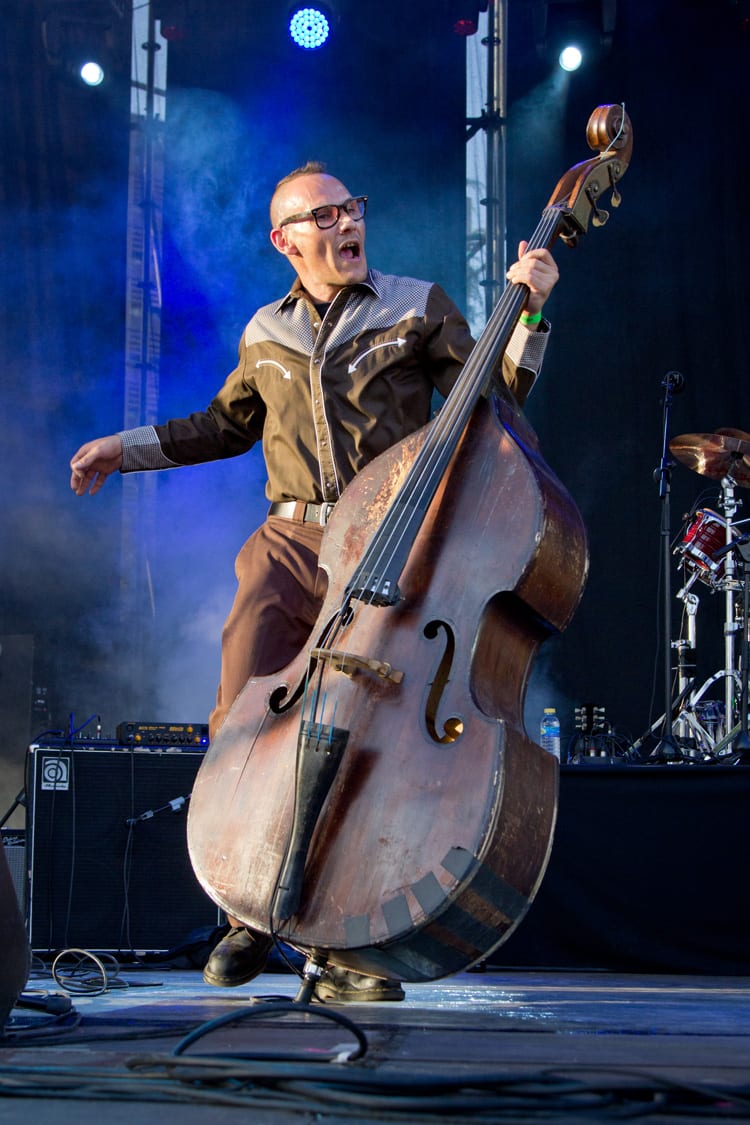Looking for bass guitar lessons? Then you’re in the right place! We’re going to take you through 9 easy bass lessons which will get you rocking in no time.
In this bass guitar lessons you will learn:
- 2 essential bass guitar scales and arpeggios.
- 2 super-easy ways to find the root notes on the bass guitar.
- The no1 secret that will enhance your picking skills.
- 3 bass lines which will make you sound amazing.
Over 100,000 guitar-learners get our world-class guitar tips & tutorials sent straight to their inbox: Click here to join them
In this epic guide, we’re going to show you 10 awesome bass guitar lessons which will get you started on your bass guitar journey today. Let’s dive in.
1) Learn To Play Root Notes
99% of the time, bass players will be playing root notes. It’s unlikely that you’ll see a bass guitarist shredding away at a million notes per second.
As a bassist, your job is to support the band by holding it down with some low-end notes.
What Is A Root Note?
The root note is the first note in a chord. This note tells us what the chord is and gives the chord its name.
For example, the root note of a C chord, is the note ‘C’.
Can you see how the root note relates to the name of a the chord.
This also works with minor chords. For example if the chord was D minor, the root note in this chord would be the note ‘D’.
Often you don’t see bass players playing chords, however you do see them playing root notes.
Pro Bass Tip!
Playing a chord’s root note will always sound fantastic. If in doubt, play the root note!
To learn more about root notes, go here: What Is The Root Note of A Chord?
How Do I Find The Root Note On A Bass Guitar?
Root notes are most commonly played on the low E and A strings on your bass. (The two thickest strings.)
Root Notes On The E String
Here are all the root notes on the low E string. (The thickest string.) It is essential for a bass guitarist to know these notes.
 Root Notes On The A String
Root Notes On The A String
You can also find root notes on the A string.
Here are all of the notes on the A string.
 Are There Any Other Root Notes On The Bass Guitar?
Are There Any Other Root Notes On The Bass Guitar?
Yes there are, here are ALL of the notes on the bass guitar:
Bass players mainly use the root notes on the E and A string because they sound nice and deep.
The main role of a bass player is to fill out the low end that a regular guitar doesn’t give us. So, if you play root notes on the D and G strings, they will be in tune, but will more than likely sound too high and trebly.
If you’re new to bass guitar, we recommend just learning the notes on the E and A strings.
2) Bass Guitar Lessons – The Major Arpeggio
The main role of a bass guitar is to fill out the rest of the band.
As a guitarist mainly plays chords, it’s worth knowing what arpeggio you could use underneath those chords.
What’s An Arpeggio?
An arpeggio is exactly the same as a chord, however when you play a chord, you play ALL the notes at once.
When you play an arpeggio you play EXACTLY the same notes as a chord, but separately.
Here’s an A major chord:
Here’s the same chord arpeggiated:
Can you hear they both sound the same? However, the arpeggio plays each note of the chord individually.
Learning The Major Arpeggio
Here’s the tab for a major arpeggio. This arpeggio is in the key of A.
Here’s what it sounds like:
You could use this arpeggio over a major chord. For example, if a A major chord is being played. You could play any of the notes of an A major arpeggio.
3) Bass Guitar Lessons – The Minor Arpeggio
Another common chord type is the minor chord. If you wanted to accompany a minor chord, you could play this arpeggio underneath.
For this example, we’ve used an A minor arpeggio.
Here’s the tab:
Here’s what it sounds like:
Why Is It Useful To Know Arpeggios?
It’s useful to know major and minor arpeggios on the bass, as each of these arpeggios contain extra notes that we can use.
Arpeggios are built off of chords, so every note in an arpeggio works over its respective chord.
It’s useful to be aware of what these chord tones are.
In a major chord these are:
- Root. (1st note in the arpeggio.)
- Major 3rd. (2nd note in the arpeggio.)
- Perfect 5th. (3rd note in the arpeggio.)
- Octave. (4th note in the arpeggio.)
In a minor chord these are:
- Root. (1st note in the arpeggio.)
- Minor 3rd. (2nd note in the arpeggio.)
- Perfect 5th. (3rd note in the arpeggio.)
- Octave. (4th note in the arpeggio.)
Being aware of what makes up these arpeggios is useful as it can help you to add colour and interest to your bass lines.
Sometimes. playing root notes is a little plain. Being able to expand on this with the use of arpeggios is incredibly useful.
Moveable Shapes
The great thing about arpeggios is that, you can move these shapes ALL over the fret board.
All you have to do is change your root note.
For example, let’s say you wanted to play a G major arpeggio.
You could play the exact same major arpeggio shape, off of the 3rd fret of the E string.
Or let’s say you wanted to play a C minor arpeggio, you simply play the minor arpeggio shape on the 8th fret of the E string.
Arpeggio Shapes On The A String?
Luckily, for us bass players, we can use both of those arpeggio shapes on both strings. They work perfectly.
Try this as a bonus challenge:
- Play a major arpeggio in any key on the A string.
- Play a minor arpeggio in any key on the A string.
Can you see how it works? The shape of the arpeggio is EXACTLY the same. You’re just moving the root note to a different string.
4) Bass Guitar Lessons – Finding Octaves On The E String
Another really useful bass guitar lessons is to find the octave points on the E and A strings.
What’s An Octave?
An octave is:
- The same note but at a different pitch.
There are two types of octaves, lower octaves and higher octaves. A lower octave is the same note but lower. A higher octave is the same note, but higher.
Listen to this audio, can you tell that the first note is lower than the second. This is a great example of what an octave sounds like.
Using Octaves On The Bass guitar
Octaves are used ALL the time on bass guitar. Using octaves is a great way of filling out space in bass line or to add texture.
They’re commonly used in funk and disco, but can be used elsewhere too.
Check out this wicked octave bass line, from Chic:
How Do I Find Octaves On The Bass Guitar?
Here are 3 simple steps you can follow to help you find the octave on a bass guitar.
- Find your root note.
For this example we’re going to use a G root note. This can be found on the 3rd fret of the E string.
- Go up two frets.
This means we would go up to the 5th fret of the E string.
- Go across two strings.
You should end up on the D string.
- Play that note.
The note you should be playing should be on the 5th fret of the D string. (This is a G note.)
Here’s what it would look like on the Bass guitar:
You can do the exact same exercise on the A string, however when you go up the octave, you end up on the G string!
Try this as a bonus challenge, try and find the following notes and their octaves:
- F note. (1st fret on the E string.)
- C note. (3rd fret on the A string.)
- D note. (5th fret on the A string.)
- B note. (7th fret on the E string.)
Find out who the greatest bass players of all time are in this article by NME: 40 Of The Greatest Bass Players of All Time
5) Bass Guitar Lessons – The Major Scale
Now you’ve learnt root notes and major and minor arpeggios. We can take this a step further and learn major and minor scales.
What’s A Scale?
A scale is a group of notes which work well together.
Scales tend to have more notes than a regular arpeggio.
Learning The Major Scale
We’re going to learn this scale in the key of A.
Here’s the tab:
Here’s what it sounds like:
Just like our arpeggios, you could move either of those scales to different root notes up and down the neck.
As well as this, you can play both of these starting on the A string too.
As a challenge, try this:
- Play this major scale shape on every fret of the E string.
- Play this major scale shape on every fret of the A string.
Get our best guitar tips & videos


 Root Notes On The A String
Root Notes On The A String Are There Any Other Root Notes On The Bass Guitar?
Are There Any Other Root Notes On The Bass Guitar?






